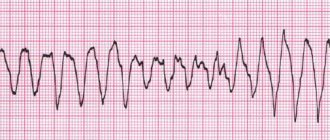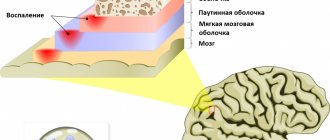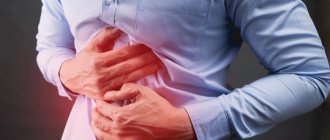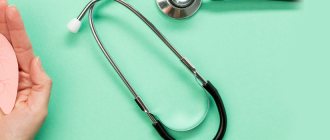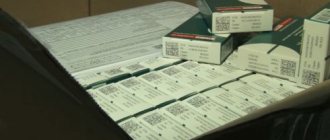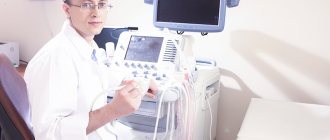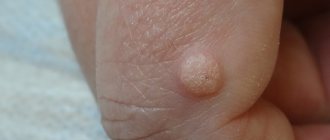Sudden cardiac arrest on the street: what to do before the ambulance arrives?
Resuscitation measures are carried out after establishing a state of clinical death, the main signs of which are: absent breathing and heartbeat, unconsciousness, dilated pupils, lack of response to external stimuli. To reliably determine the severity of the situation, it is necessary to determine the following indicators of the victim:
- check the pulse in the carotid arteries of the neck at the jaw angle - when the pressure drops to less than 60-50 mm Hg. Art. the pulse on the radial artery of the inner surface of the hand is not detected;
- examine the chest, check for spontaneous breathing movements;
- approach the victim’s face to check breathing, determine inhalation and exhalation (air movement assessment);
- pay attention to the color of the skin - cyanosis and severe pallor appear when breathing stops;
- check consciousness - lack of response to stimuli indicates coma.
Cardiopulmonary resuscitation according to the new standards is carried out only in two cases. You should start performing CPR only after determining your pulse and breathing.
If the pulse is clearly detected for 10-15 seconds and atonal breathing is disturbed with episodes of convulsive sighs, artificial respiration is required. To do this, you need to take 10-12 breaths “mouth to mouth” or “mouth to nose” over the course of a minute. While waiting for an ambulance, you need to measure your pulse every minute; if it is absent, CPR is indicated.
If spontaneous breathing and pulse fail, a set of resuscitation measures is indicated strictly according to the algorithm.
Consciousness testing is carried out according to the following principle:
- Address the victim loudly. Ask what happened and how he feels.
If there is no response, use painful stimuli. Pinch the top edge of the trapezius muscle or apply pressure at the base of the nose.- If there is no reaction (speech, twitching, attempts to defend yourself with your hand) - there is no consciousness, you can move on to the next stage.
Breath test:
- Tilt your head back (holding it by the back of your head and chin) and open your mouth. Inspect it for foreign bodies. If they are there, remove them.
- Bend towards your face and for 10 seconds. check your breathing. You should feel it with your cheek and hear and see the movements of your chest. Normally, 2-3 breaths are sufficient.
- If there is no breathing or only 1 breath is felt (which can be considered its absence), we can assume the cessation of a vital function.
In such a case, it is necessary to call an ambulance and begin performing resuscitation measures in case of cardiac and respiratory arrest.
Behavior rules
Providing first aid in the absence of consciousness, cessation of breathing and circulation.
The main signs of life in the victim
The main signs of life include the presence of consciousness, independent breathing and blood circulation. They are checked during the CPR algorithm.
Causes of respiratory and circulatory disorders
I
Sudden death (respiration and circulatory arrest) can be caused by diseases (myocardial infarction, heart rhythm disturbances, etc.) or external influences (trauma, electric shock, drowning, etc.). Regardless of the reasons for the disappearance of signs of life, cardiopulmonary resuscitation is carried out in accordance with a specific algorithm recommended by the Russian National Council for Resuscitation and the European Council for Resuscitation.
Methods for checking consciousness, breathing, and blood circulation in a victim
When providing first aid, the simplest methods are used to check for the presence or absence of signs of life:
- to check consciousness, the first aid participant tries to enter into verbal and tactile contact with the victim, checking his reaction to this;
— touch, hearing and vision are used to check breathing (the technique for testing consciousness and breathing is described in more detail in the next section);
- the lack of blood circulation in the victim is determined by checking the pulse in the main arteries (simultaneously with determining breathing and with appropriate preparation). Due to the insufficient accuracy of checking the presence or absence of blood circulation by determining the pulse in the main arteries, it is recommended to focus on the absence of consciousness and breathing when making a decision on performing cardiopulmonary resuscitation.
Modern algorithm for performing cardiopulmonary resuscitation (CPR). Technique for applying manual pressure to the victim’s sternum and performing artificial respiration during CPR
At the scene of an incident, the first aid provider should assess the safety for himself, the victim(s) and others. After this, threatening factors should be eliminated or the risk of injury to oneself, the risk to the victim(s) and others should be minimized.
Next, it is necessary to check the victim’s consciousness. To check consciousness, you need to gently shake the victim by the shoulders and ask loudly: “What’s wrong with you? Do you need help? A person who is in an unconscious state will not be able to react and answer these questions.
In the absence of signs of consciousness, it is necessary to determine whether the victim is breathing. To do this, it is necessary to restore the patient’s airway: place one hand on the victim’s forehead, take the chin with two fingers of the other, throw back the head, lift the chin and lower jaw. If a cervical spine injury is suspected, tilting should be performed as carefully and gently as possible.
To check breathing, lean your cheek and ear toward the victim’s mouth and nose and hold for 10 seconds. try to hear his breathing, feel the exhaled air on your cheek and see the movements of the victim’s chest. In the absence of breathing, the victim’s chest will remain motionless, the sounds of his breathing will not be heard, and the exhaled air from the mouth and nose will not be felt by the cheek. Lack of breathing determines the need to call an ambulance and perform cardiopulmonary resuscitation.
If the victim is not breathing, the first aid provider should arrange for an ambulance to be called. To do this, you need to loudly call for help, addressing a specific person located near the scene of the incident and give him appropriate instructions. Instructions should be given briefly, clearly, and informatively: “The person is not breathing. Call an ambulance. Let me know you've been called."
If it is not possible to attract an assistant, you should call emergency medical help yourself (for example, using the speakerphone function on your phone). When calling, be sure to provide the dispatcher with the following information:
• location of the incident, what happened;
• number of victims and what happened to them;
• what kind of assistance is provided.
Be the last to hang up the phone after the dispatcher answers.
Emergency medical services and other special services can be called by calling 112 (can also be made by calling 01, 101; 02, 102; 03, 103 or regional numbers).
Simultaneously with calling emergency medical services, it is necessary to begin applying pressure with your hands on the sternum of the victim, who should be lying on his back on a hard, flat surface. In this case, the base of the palm of one hand of the first aid participant is placed in the middle of the victim’s chest, the second hand is placed on top of the first, the hands are clasped, the arms are straightened at the elbow joints, the shoulders of the first aid participant are positioned above the victim so that the pressure is applied perpendicular to the plane sternum.
Hand pressure on the victim’s sternum is performed with the weight of the torso of the first aid participant to a depth of 5-6 cm with a frequency of 100-120 per minute.
After 30 manual pressures on the victim’s sternum, artificial respiration must be performed using the “mouth-to-mouth” method. To do this, open the victim’s airways (throw back his head, raise his chin), pinch his nose with two fingers, and take two breaths of artificial respiration.
Inhalations of artificial respiration are performed as follows: you need to take your normal breath, seal your lips around the victim’s mouth and exhale evenly into his airways for 1 second, observing the movement of his chest. The benchmark for a sufficient volume of injected air and effective artificial respiration inhalation is the beginning of the rise of the chest, determined visually by the first aid participant. After this, while continuing to maintain patency of the airways, it is necessary to allow the victim to exhale passively, and then repeat the inhalation of artificial respiration in the manner described above. No more than 10 seconds should be spent on 2 breaths of artificial respiration. You should not make more than two attempts to inhale artificial respiration in between manual pressures on the victim’s sternum.
In this case, it is recommended to use a device for artificial respiration from a first aid kit or bed.
If it is impossible to perform artificial respiration using the “mouth-to-mouth” method (for example, the victim’s lips are damaged), artificial respiration is performed using the “mouth-to-nose” method. In this case, the technique differs in that the first aid participant closes the victim’s mouth while throwing back his head and covers the victim’s nose with his lips.
Next, resuscitation measures should be continued, alternating 30 compressions on the sternum with 2 breaths of artificial respiration.
Errors and complications that arise when performing resuscitation measures
The main mistakes when performing resuscitation measures include:
— violation of the sequence of cardiopulmonary resuscitation measures;
- incorrect technique for applying manual pressure on the victim’s sternum (incorrect placement of hands, insufficient or excessive depth of pressure, incorrect frequency, lack of full elevation of the chest after each pressure);
— incorrect technique for performing artificial respiration (insufficient or incorrect opening of the airways, excessive or insufficient volume of blown air);
— incorrect ratio of manual pressure on the sternum and artificial respiration breaths;
- the time between manual pressure on the victim’s sternum exceeds 10 seconds.
The most common complication of cardiopulmonary resuscitation is fracture of the chest bones (mainly ribs). Most often this occurs when there is excessive force of hand pressure on the victim’s sternum, an incorrectly determined position of the hands, or increased bone fragility (for example, in elderly and senile victims).
The frequency of these errors and complications can be avoided or reduced with regular and high-quality training.
Indications for stopping CPR
Resuscitation measures continue until the arrival of ambulance or other special services, whose employees are required to provide first aid, and the order of the employees of these services to stop resuscitation, or until the appearance of obvious signs of life in the victim (the appearance of spontaneous breathing, coughing, voluntary movements).
In case of prolonged resuscitation measures and physical fatigue occurs in the first aid participant, it is necessary to involve an assistant in the implementation of these measures. Most modern domestic and foreign recommendations for cardiopulmonary resuscitation provide for changing its participants approximately every 2 minutes, or after 5-6 cycles of pressure and inhalation.
Resuscitation measures may not be carried out for victims with obvious signs of non-viability (decomposition or injury incompatible with life), or in cases where the absence of signs of life is caused by the outcome of a long-term incurable disease (for example, cancer).
Stages of cardiopulmonary resuscitation according to new standards
It is extremely important to follow the correct procedure for resuscitation measures. According to the latest medical protocols, to save the victim it is necessary to adhere to the following algorithm:
- A - ensure airway patency for oxygenation, eliminate blockage of the lumen of the pharynx and trachea;
- B - perform breathing using the “mouth to mouth” or “mouth to nose” method;
- C - restore blood circulation using indirect massage.
Technique and procedure for performing indirect cardiac massage and artificial ventilation of the lungs
- It is important to maintain safety; before starting CPR, the person must be placed on a rigid, stable and solid surface or floor.
- After this, tilt your head to the side, open your mouth slightly and make sure that the airway is not blocked. If obstruction is detected, clear the airways using improvised means (handkerchief or napkin).
- For effective artificial respiration, perform the Safar maneuver - tilt your head back, push your jaw forward and upward, and open your mouth in one movement.
- If there are signs of a spinal fracture in the neck area, just move your jaw.
- The resuscitation complex begins with 30 compressions of the sternum, which are performed by one person rhythmically without breaks.
- To do this, you need to place your right hand with your palm resting on the lower part of the sternum in the center, place your left hand on top of your right hand and interlace your fingers.
To perform a heart massage, your arms should be straight, not bent at the elbow joints.- Perform 100-120 compressions per minute with rhythmic compression of the sternum 5-6 cm deep, until the chest is completely expanded after compression.
- After 30 compressions, exhale 2 times into the victim’s mouth or nose for 1 second.
- When breathing using the mouth-to-mouth method, you must close your nostrils with your fingers before exhaling.
- During two exhalations, you should look at the chest: straightening and lifting indicate correct execution.
- If the chest does not rise or fall, it is necessary to check whether the airways are passable, and you may need to repeat Safar.
- During CPR, be sure to check your pulse every 2 minutes. Resuscitate without stopping for up to 30-40 minutes.
Criteria for the effectiveness of activities
With timely assistance, the chance of saving a person increases. To do this, it is important to strictly follow the rules of cardiopulmonary resuscitation. The effective implementation of the CPR complex is indicated by:
- the appearance of a pulse in the carotid arteries - to make sure that the pulse is maintained, cardiac massage can be stopped for 3-5 seconds;
- return of the pupillary reaction to a light stimulus - narrowing indicates an enrichment of oxygenated blood in the brain;
- the appearance of spontaneous breathing with full, steady inhalation and exhalation, without episodes of convulsive inhalations followed by cessation (apnea);
- disappearance of blueness of the skin of the face, lips, hands;
After the heartbeat and breathing are restored, the resuscitation complex is stopped, but the victim must remain in the field of view of the resuscitator until the doctor arrives
Common mistakes in providing assistance
It should be remembered that incorrectly provided first aid often causes more harm than its absence. The following erroneous recommendations and myths are often found on the Internet (the rule of four “NOT”):
- Do not check your breath with a mirror or feather - you waste time looking for it, the humidity outside may interfere with your breathing, and when using a feather, the wind can interfere with the reliability of the result. In such a situation, you will mistakenly consider the dead person to be alive.
Do not check the pupillary reflex - you need to be able to do this correctly and not with the help of a regular flashlight. If a person is alive, too bright light in certain diseases can damage the retina. Finally, there are neurological disorders in which this reflex will not work in a person with preserved vital functions.- You shouldn't do a precordial blow. This requires appropriate practice, moreover, this method has not been proven in terms of effectiveness, and in some cases it can cause even greater harm.
- Do not perform mechanical ventilation without protection (without a film valve) on strangers - there is a high risk of transmission of infection. If the chest does not rise during artificial ventilation, it should be assumed that air is passing into the stomach, or the airways are blocked. In the first case, limit yourself to NMS; in the second, clean your mouth or use the Heimlich maneuver.
Basic Concepts
Nowadays, you can often hear from the media that people die “out of the blue,” the so-called sudden death. In fact, anyone can face sudden death at any time and anywhere. And in order to be able to save a dying person, you need to master some basic skills, which include CPR.
Cardiopulmonary resuscitation (CPR) is a set of emergency measures that are performed to bring a person out of clinical death (to revive a person).
Clinical death is a reversible condition in which breathing and circulation completely stop. The reversibility of this condition ranges from 3 to 7 minutes (this is how long our brain can live without oxygen). It all depends on the ambient temperature (survival increases in the cold) and the initial condition of the patient.
It is important that resuscitation measures are started immediately after clinical death is diagnosed. Otherwise, the cerebral cortex will die and then, even if it is possible to resume cardiac activity, we will lose the person as an individual. A person will turn into a vegetable who will no longer be able to regulate any vital processes. Only his body will exist, which will be able to breathe only with the help of an apparatus, and feed exclusively through special systems.
Emergency assistance from the medical team: what is the algorithm of action?
To provide emergency care in case of sudden cardiac arrest, a special cardiology team arrives on site, whose task is to carry out advanced resuscitation measures and immediately transport the patient to the hospital. It works according to a protocol that includes the following sequence of actions:
- Checking vital signs and making a diagnosis. For this purpose, a wider arsenal of equipment is used, including an electrocardiograph. It is necessary to exclude other causes of clinical death, such as bleeding or blockage.
Resumption of conductivity of the upper respiratory tract. To ensure maximum oxygen supply, they are intubated.- Resuscitation measures are carried out according to the same algorithm as indicated above, but for mechanical ventilation they use breathing masks, an Ambu bag or a ventilator.
- In the presence of atrial fibrillation or ventricular fibrillation on the ECG, the question of using defibrillation is raised.
- Drug support is provided by intravenous or intracardiac administration of drugs such as Adrenaline (1 ml 0.1% in 19 ml NaCl 0.9%) and Cordarone (in the presence of arrhythmias, 300 mg IV).

